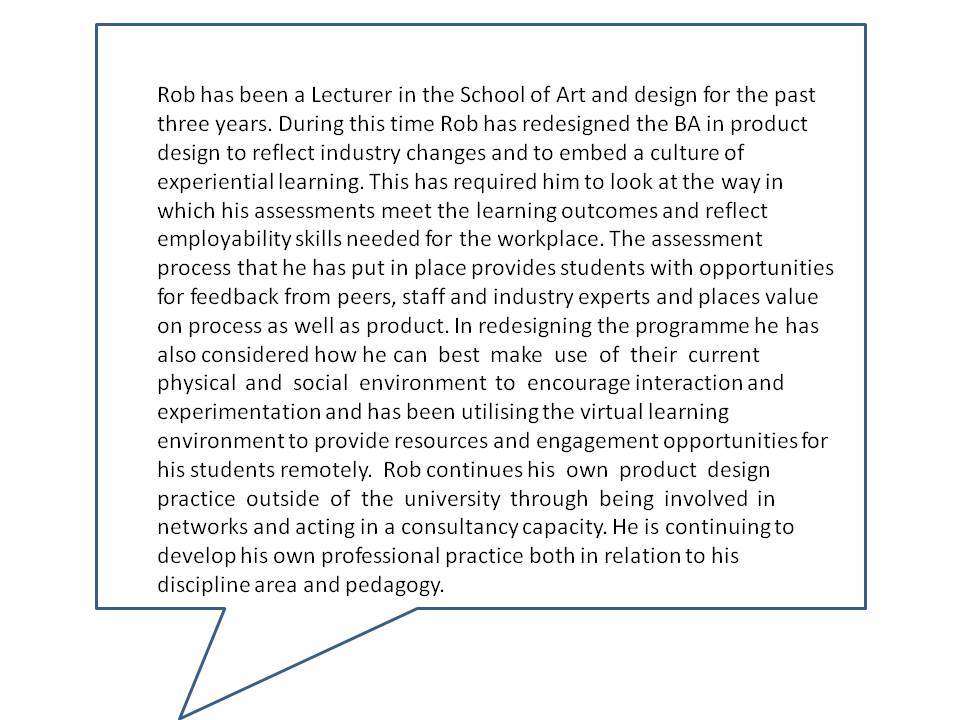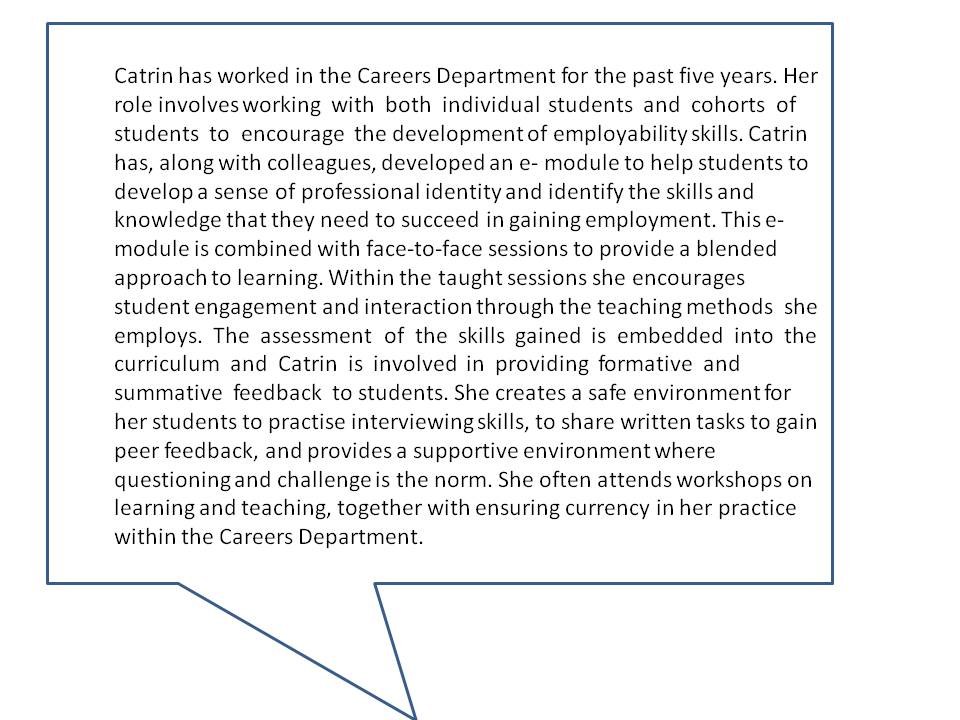Fellow (Descriptor 2)
On this page:
- Typical Applicants
- Differentiation at Descriptor 2
- Statements at Descriptor 2
- Vignettes
- Evidence at Descriptor 2
- Application Process
Typical Applicants
Applicants for recognition at this level will be able to provide evidence of broadly based effectiveness in more substantive teaching and supporting learning.
- Early career academics
- Academic-related and/or support staff holding substantive teaching and learning responsibilities
- Experienced academics relatively new to UK higher education
- Staff with (sometimes significant) teaching-only responsibilities including, for example, within work-based settings
Differentiation of Descriptor 2
Within this Descriptor, individuals need to be able to demonstrate engagement and success in all the Dimensions of the UKPSF including Areas of Activity, Core Knowledge and Professional Values. This will be influenced by the subject, profession and discipline context in which the individual is working and the expectations of the institution. Evidence of the engagement in continuing professional development (CPD) activities and the integration of subject and pedagogic research and/or scholarship, with specific regard to learning and teaching and which result in the enhancement of their teaching should be articulated. These activities are likely to be wide ranging and will draw on both formal and informal approaches to CPD.
Statements at Descriptor 2
Individuals should be able to provide evidence of the following six statements:
- Successful engagement across all five Areas of Activity
- Appropriate knowledge and understanding across all aspects of Core Knowledge
- A commitment to all the Professional Values
- Successful engagement in appropriate teaching practices related to Areas of Activity
- Successful incorporation of subject and pedagogic research and/or scholarship within the above activities, as part of an integrated approach to academic practice
Vignettes
Evidence at Descriptor 1 and 2
Summary of your learning and teaching philosophy (~300words)
This section provides an opportunity for you to outline your learning and teaching philosophy and how this reflects your Professional Values. This is a reflective statement of your practice (over the past 5 years) reflecting your philosophy. The statement will be informed by all the Dimensions and appropriate Descriptor of the UKPSF.
Area of activity 1 - Design and plan learning activities and/or programmes of study (~600 words)
This area is about how you plan for learning, and the ways in which you contribute to the design and planning of learning activities. These might include involvement in the design or redesign of curricula, courses and programmes of study and/or identifying and planning different kinds of interaction with learners in various contexts for single sessions or larger programmes.
Equally it might include indirect involvement through, for example, participation in validation panels, contribution to the creation of learning resource packs and computer-based or open learning materials or the development of virtual learning environments.
Other activities equally valid include personal tutoring, internal/external examination responsibilities, disability support, e-learning support, acting as ‘critical friend’ to a colleague, peer observation activity, mentoring of students or other staff, research related to design or planning.
Within your own work context, consider the contribution you make to design and planning of learning, your choice of approach to this activity, and how your chosen approach contributes to the learners’ understanding of the subject.
Evidence should reflect an understanding of the pedagogic literature in this area, and might include principles of curriculum design such as constructive alignment, and principles of teaching method. Assessment method may also be considered and discussed in relation to design and planning.
Area of activity 2 - Teach and/or support learning (~600 words)
This area is about how you work with learners including students and other staff. Consider the range of teaching and learning activities or techniques you use and comment on how you came to use them and why you think they are successful in supporting student learning. In addition to lecturing, tutorial and seminar work the activities might include, for example, studio, clinical, laboratory or workplace-based teaching, distance learning and the use of virtual learning environments. Support might include, for example, teaching and supervision of postgraduates, mentoring inexperienced staff or contributing to in-house learning and teaching programmes.
Other activities that could be included are co-working with a colleague, acting as ‘critical friend’ to a colleague, peer observation activity, mentoring of students or other staff.
Within your own work context, consider reasons for your choice of activities and techniques and how they relate to developing the learners’ understanding of the subject.
Evidence should reflect an understanding of the pedagogic literature in this area, and might include principles of student-centred learning, the appropriate use of various teaching methodologies, an awareness of appropriate student support, and connection with curriculum design decisions.
Area of activity 3 - Assess and give feedback to learners (~600 words)
This area is about your approach to assessment and feedback to learners, whether they are students or other staff.
Consider the types of formative and/or summative assessment you use with learners, whether formal or informal. Justify how and why you choose the approaches and methods you use, in so far as this is your own decision. In your justification you may wish to address the issues of how you ensure your assessments are valid indicators of what you want your learners to learn, that the marking is reasonably reliable and the standards you set are appropriate.
Consider how you give feedback to learners (e.g. in writing, orally, as part of the supervision of research students). Justify how you try to ensure that the feedback you give to learners helps them to improve their performance and develop as learners.
Other activities that could be included are giving feedback to colleagues, acting as ‘critical friend’ to a colleague, peer observation activity, mentoring of students or other staff.
Within your work context, give reasons for your choice of activities and techniques and how they relate to developing the learners' understanding of the subject.
Evidence should reflect an understanding of the pedagogic literature in this area, and might include principles of formative and summative feedback and assessment, assessment for learning (rather than of learning), recognition of the diversity of the student cohort, and connection with curriculum design decisions.
Area of activity 4 - Developing effective learning environments and approaches to student support and guidance (~600 words)
This area is about the ways in which you provide support for learners. Consider the range of ways in which you contribute to making the learning environment effective for learners.
Developing effective learning environments might include:
- managing the physical environment or virtual environment so that they are appropriate to the learners’ needs
- working with learners and service providers to ensure that learners can access and use a broad range of learning opportunities
liaison and planning activities in support of fieldwork or work placements
You may also wish to consider how, from the students’ perspective, the aims and objectives, teaching and learning methods and assessment processes are appropriately aligned.
Learner support might include such activities as personal and academic tutoring, one-to-one advice, counselling (where appropriate to your work role), developing practice to meet the learning implications of widening access, work placement or project supervision, supporting learners with disabilities, learner support in IT/ study skills workshops etc, laboratory work, studio critiques, information retrieval and management.
Within your work context, consider reasons for your choice of approaches and how they relate to developing the learners' understanding of the subject.
Evidence should reflect an understanding of the pedagogic literature in this area, and might include principles of student-centred learning, the way in which students learn, current thinking on learning environments and social spaces, recognition of the diverse needs of the student population, and how we might provide equitable access to learning for all.
Area of activity 5 – Engage in continuing professional development on subjects/disciplines and their pedagogy, incorporating research, scholarship and the evaluation of professional practices. (~600 words)
This area is about how you evaluate the effectiveness of your practice and engage in CPD to improve it. This may include the use of research, scholarly activity and/or professional activities to develop your practice to enhance student learning.
Consider how you evaluate your own teaching/learning support activities, both formally and informally, and how you use your findings to improve the student learning experience and your working practice. Consider how you seek feedback on your practice from colleagues and learners and how you evaluate this feedback. Provide examples to show how you have used feedback in developing subsequent activities.
You could also refer here to any activities you have undertaken to update yourself on aspects of teaching and learning, for example, staff development activities or conferences on learning and teaching or participation in projects to develop learning methods. Indicate how you have used the learning from these activities in your own teaching.
You could also include peer learning opportunities, working groups and other professional groups where appropriate. You may include co-working relationships with more experienced colleagues, peer learning/ peer observation opportunities, mentoring opportunities, work placements including the clinical environment, work shadowing etc, one’s own professional practice (e.g. as designer, sports coach, dietitian).
Any evidence of how you continue to keep up to date in your role/subject area can be included, e.g. reading papers, articles, etc, attending conferences, becoming familiar with new legislation, employment regulations, new ideas. Consider ways in which you draw upon discipline-based and pedagogic research, scholarly activity and/or other professional activities in the support of your role. Activities undertaken as part of a group or team are valued as much as individual activities. Relevant professional activities may include those you engage in outside the higher education context.
Within your role, consider how you have actively sought opportunities to use research, scholarly activity and/or professional activities to create connections to enrich your teaching and/or support of learning.
This area may include your own publications in print, web or other format, or the use of others’ publications or expertise. It may include attendance and/or presenting papers at conferences, subject based professional bodies, common interest groups, associations/ societies etc, working groups, employer liaison groups. You may include funding you have secured. You may also include peer review or other editorial activities for journals/ conferences/ professional publications etc.
You may include discussion of the relationship between research, scholarship and teaching in your discipline area, e.g. innovative curriculum design, innovative assessment, student involvement in research, etc.
Application Process for Descriptors 1 and 2 (Associate Fellow or Fellow)
Applicants submit by written application on the provided proforma. This must be submitted d in digital format to fellows@aber.ac.uk.
This will include:
FHEA Checklist
|
FHEA
|
|
|
|
Application Form
Total word count |
|
3.000 words max |
|
Personal details
|
|
✓ |
|
Teaching Philosophy Statement/ |
A brief summary of your learning and teaching philosophy |
✓ 500 words |
|
Claim Grid
|
Claim grid: Evidence of the three Dimensions of the UKPSF. All 5 Areas of Activity and all Areas of Activity for D2. Statements must demonstrate all the dimensions of the UKPSF |
✓ 2,000 words |
|
2x Peer Observation Reflective Statements
|
|
✓ 500 words |
|
Other information
|
|
✓ |
|
CPD Plan |
A CPD plan for future personal development in teaching and supporting learning.
|
✓ |
|
Referee statements
|
|
✓ x 2 |
|
Institutional/Line Manager’s verification statement |
|
✓ |


